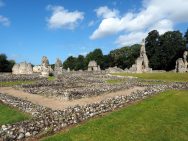Taking advantage of the good weather yesterday, we planned a day trip that combined a closer look at Thetford (otherwise known as actually stopping there rather than simply driving through) with a visit to a couple of English Heritage sites; all free anyway, but nonetheless, more of an incentive to seek out less familiar haunts.

Thetford is about an hour’s drive from home and our first stop off, Thetford Priory, was just off the centre of the town. Well, I say just off, it proved difficult to find and, even though there was a small Priory car park, it initially proved a little elusive. What was even more surprising however was entering the Priory grounds and discovering just how extensive the priory grounds were. The Priory of our Lady of Thetford (to give it the full name) was one of the largest and most important monasteries in medieval East Anglia. Founded in the early 12th century, for 400 years it was the burial place of the Earls and Dukes of Norfolk, and enjoyed their powerful protection. It was because of this that Thetford was one of the last monasteries to be suppressed when it surrendered to Henry VIII’s commissioners in 1540. The extensive surviving remains include the lower walls of the church and cloister, together with the impressive shell of the prior’s lodging and an almost complete 14th century gatehouse. Having seen the entry in the handbook, we were delighted to see the extent and scope of the ruins. Hopefully, the photo gives some sense of the scale…and just a short walk from this site is the Church of the Holy Sepulchre – the only surviving remains in England of a priory of canons of the Holy Sepulchre, who aided pilgrims to Christ’s tomb. The ruined nave of their 14th-century church, later used as a barn, survives.
After the visits, we chanced a coffee (excellent) in the cafe in the town high street. Thetford town centre also proved to be both welcoming and attractive with much to see. Many of the museums are of course currently closed but that just incentivised us to return! We then drove 10 miles or so to find Weeting Castle, which, like a few other “castles”, is really the ruins of a substantial early medieval moated manor house, built in local flint.

Another low key approach, the local and very limited lane parking also had the benefit of leading to the very lovely St Mary the Virgin Church, with its round tower containing two bells, which is adjacent to the ruined 12th century Weeting Castle and stands on the north eastern edge of the village facing open agricultural land. Its origins are 11th or 12th century, with some 14th century work but the whole building received a total renovation in the 19th century by John Angerstein, the owner of Weeting Hall. The Hall was demolished in the 1950s.
All in all, a lovely day out and special thanks to Mrs. No Name for all the driving involved.
